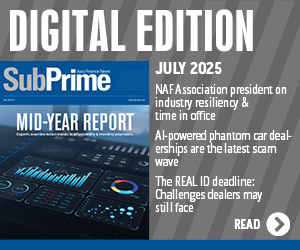GM Financial Still Satisfied with Subprime Penetration
While General Motors Financial no longer is strictly the AmeriCredit used-vehicle financing platform of 10 years ago after acquiring a wide array of international interests, company leadership remains pleased with its position and performance in terms of originations to subprime customers for new and used vehicles at GM dealers or other stores.
The company highlighted that its subprime penetration for parent automaker loans held steady in the fourth quarter at 7.2 percent, a level still above what GM Financial indicated was the industry average of 5.9 percent.
"GM still has a pretty comfortable lead in terms of industry penetration," GM Financial president and chief executive officer Dan Berce said.
Meanwhile, penetration of GM Financial's AmeriCredit brand that's still utilized by non-GM dealers gained traction year-over-year, too, rising to 53.6 percent from 42.9 percent.
"We still have a significant AmeriCredit-branded used-car business in North America," Berce said.
As GM Financial highlighted penetration gains when it reported its 2013 financial performance last week, the company's origination totals for North America softened a bit in Q4.
The company generated a total of $1.146 billion in North American originations during the fourth quarter, a figure that included loans on new and vehicles turned at GM stores as well as loans originated on vehicles at non-GM dealerships. That figure was down $124 million sequentially and $70 million year-over-year.
With those numbers in mind, Berce pointed out trends that seem clear to him.
"No. 1 you do see the seasonality come out pretty clearly where the first quarter, second quarter of the calendar year are typically stronger. The fourth quarter, the weakest. So we did see the normal seasonality trends," Berce said.
"Second of all, we saw pretty stable year-over-year volumes on the used-car and AmeriCredit-branded side," he continued. "That is despite the fact that there was pretty good industry growth. So we were flat, and the industry was up. And that is, again, a result of the fact that the market is quite competitive. And we have chosen to stay very disciplined from a pricing and credit standpoint. So we have given up market share. Even though the numbers are flat origination-wise, our market share is down.
"On the GM new-vehicle side, that did decrease year-over-year," Berce went on to say. "And that is really a function of fact that in today's very low interest rate environment we are seeing at the top end of the subprime market, standard rates competitive with our subvented rates. And that has caused a little bit of volume to go away from us on the GM new-vehicle side.
"Again, our mandate, though, is to make sure GM has a strong penetration for subprime, and they do. So where the loan is captured by GM Financial or at a lower rate by a bank participant, let's say, our mandate is clearly held in that case," he added.
In terms of portfolio performance, GM Financial reported jumps in both charge-offs and delinquencies in Q4, movements Berce again described as seasonal.
The company's North American Q4 charge-offs increased from $118 million to $183 million year-over-year. Meanwhile looking at the same time comparison, contracts up to 60 days delinquent rose from 6.1 percent to 7.5 percent. The rise left GM Financial total amount of North American delinquencies as of the fourth quarter at 10.0 percent, up from 8.2 percent a year earlier.
"Here you do see the seasonality, just like you saw for originations," Berce said. "The mid part of the year is typically the strongest for credit losses and delinquencies. The fourth quarter, typically, the weakest. So here you are seeing that with December 2013 credit losses at 3.5 percent, up slightly from 3.3 percent last year, and delinquencies rising year-over-year.
"We continue to see what we have referred to in the past as credit normalizing. Credit has been extraordinary the last few years. We are seeing that revert to the norm that we've seen in our business over our 20-year-plus history," he continued.
"Delinquency at calendar year end did move a little higher than what we probably expected," Berce went on to say. "The good news is January it spiked down more than it normally does, so no concerns on that front. Performance of GM new vehicles from a credit standpoint remains in line or better than performance of our used-car or AmeriCredit-branded business."
Impact on Quarterly Bottom-Line Performance
So what did all of the origination, charge-off and delinquency development do to GM Financial's primary financial performance.
The company reported earnings of $121 million for the fourth quarter, compared to $91 million during the year-ago quarter. GM Financial's earnings for the year totaled $566 million, up from $463 million in 2012.
GM Financial indicated earnings include $13 million and $42 million in pre-tax acquisition and integration expenses and $15 million in pre-tax charges associated with discontinuing the Chevrolet brand in Europe for the quarter and year end, respectively.
The company had total available liquidity of $3.9 billion as of the close of 2013, consisting of $1.0 billion of unrestricted cash, $1.7 billion of borrowing capacity on unpledged eligible assets, $615 million of borrowing capacity on unsecured lines of credit and $600 million on a line of credit from GM.
Update on Commercial Lending Performance
GM Financial also highlighted the steady rise of its commercial portfolio, of which 89 percent constitutes floor planning accounts for parent-automaker stores.
The company wrapped up the year with $1.975 billion in commercial receivables, marking a steady march higher from the year-ago figure of $806 million.
The dealer count is on the move higher, too. GM Financial said 309 franchised stores are using the product, up from 108 at the close of 2012, the first year the company offered the platform.
"We continue to see good, steady progress in growing that book," Berce said. "In the fourth quarter, we had our best quarter of growth yet. We added over 50 dealers and $600 million of outstandings. So better momentum there, steady progress."


